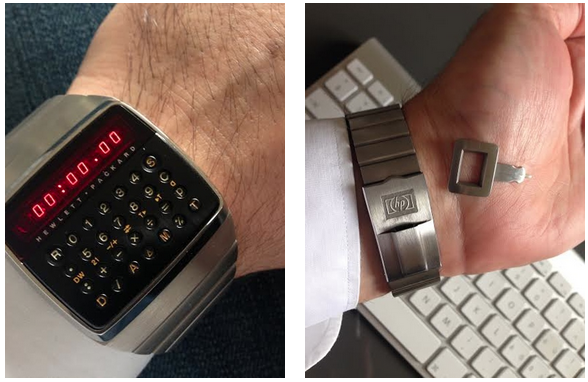
When history buffs recant that history repeats itself, most listeners nod in an absent-minded agreement, unable to provide a single concrete example but conscious that some correlation between past and present exists. If you want to make these folks feel utterly flabbergasted, simply tell them that the first smart watch was actually constructed 38 years ago, decades before the Apple Watch, Android Wear, or Pebble.
The watch in question is not some archaic version of the 90s’ Casio calculator watch, but some beastly device called the HP-01 that achieved an unprecedented level of complication in 1977 with its seven character bright-red LCD display, 28-button keyboard, built-in ability to store and recall data, alarm clock, stop watch, calculator, and a 200-year calendar. All this was powered by three batteries stuffed along with six circuit boards into a 40 mm x 45 mm x 15 mm frame that weighs 6 ounces (170 grams) — massive by watch standards.

The HP-01 wasn’t the first calculator watch, that honor goes to the 1975 Calcron and Pulsar device, but it was the first to tie in so many “smart” features within a single package. Its advertising motto put it: “With the HP-01, you can compute and then count down the time it takes for a command to reach a spacecraft several hundred million miles away.” Which is not far from the truth; by permitting users to manipulate metrics like time and speed, the watch can technically calculate the required travel time to a specific point, or determine the date when a specific task would end.
What’s more, HP-01’s ability to recall data meant that the watch could double as digital agenda; although, typing on the miniature keyboard wasn’t an easy task, particularly for those with “sausage fingers.” The crafty HP designers foresaw this problem and designed a discrete stylus that could be tucked away in the bracelet buckle.

The watch could maintain an accuracy of up to 30 seconds per year, a feat considered relatively impressive by the standard in which we evaluated quartz movement with digital displays at that time. Even today, average quartz watches are precise up to 15 seconds per year.
So, how much would this baby set you back? In 1977 it costs $695, which, after adjusting for inflation, is equal to $2,729 by today’s value. Clearly, way, way more than contemporary smart watches.
Source: Hodinkee.com
Advertisement
Learn more about Electronic Products Magazine





